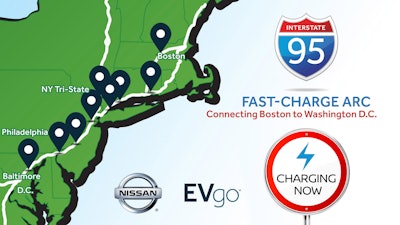
True, it’s not nearly as monumental as that final leg of the railroad out west, but it’s still noteworthy.
Nissan, the manufacturer of the most popular EV in the world, the Leaf, worked with partner EVgo to provide enough DC fast chargers for EV drivers to make the 500-mile trip between Boston and Washington, D.C.
The ‘I-95 Fast Charging ARC’ provides 52 50kW fast chargers split between nine EVgo stations that are mostly located close by to I-95. The sites rank among the largest fast charging stations available to the public.
Okay, so Leaf today, but trucks and vans tomorrow? It’s a definite possibility. The Tesla Semi has been able to venture out from its California play-pen and make its recent cross-country visits thanks to the automaker’s ever-growing Supercharger sites which routinely charge up its passenger vehicles and which will probably be charging up Tesla’s pickup which CEO Elon Musk announced Friday is still in the works.
But here’s where EVs begin to get a little more complicated—again. This time it’s not about diminished capabilities in larger vehicles classes, battery volatility, recycling and disposal issues. All important points. I’m referring to charging standardization, or in Nissan’s case, the apparent lack thereof.
As Penske reminded readers recently, the Charging Interface Initiative, or CharIN, of which Penske is a member, exists to establish an efficient and versatile charging standard around the world. Check out the member list some time. All major OEMs are there accept Nissan. This substantial EV manufacturer has seemingly packed up all its marbles and headed home.
Why? At the core of Nissan’s reluctance to cuddle up to CharIN are differences in battery formats. Nissan utilizes the CHAdeMO (Charge de Move) system while CharIN favors CCS (Combined Charging System). Both systems are capable of DC fast-charging.
But so are Tesla’s Superchargers, which employ another charging system and yet it still joined CharIN. And then there’s BYD, the largest EV manufacturer in the world by far. The China-based company relies primarily on the Chinese GB/T fast-charging system, yet it too joined CharIN. Oddly enough, the Nissan’s’ ARC partner EVgo is a member. So why not Nissan?
The CharIN CCS vs. CHAdeMO debate may not be as important or as interesting as the legendary Thomas Edison v. Nikola Tesla battle (DC vs AC power supply), but it’s still important considering that the EV market shows no signs of slowing across all vehicle classes.
Nissan appears to have given a nod to CharIN as the ARC stations will feature both CHAdeMO and CCS charging formats, but it’s reluctance to fully commit and join CharIN may signal some frustrating times ahead for EV drivers of all vehicle classes.
CHAdeMO tech came into the fold first and offers customers an option of selling battery juice back into the grid—an enticing idea that recalls home solar systems which also allow for selling unused power to a utility. But the home solar idea makes much more sense.
I suppose if you have a small route the next day and don’t anticipate using as much juice in your EV, then you could cash in on the idea. Otherwise, a busy life like mine with kids factors in a level of chaos that includes last-minute runs to God knows where. Fleets often operate that way as well. A vehicle break-down or customer demand may necessitate a change in driving plans making vehicle readiness a priority.
Nissan’s obviously got a lot invested in CHAdeMO and with today’s announcement, it’s not backing away from the technology.
But CCS has some advantages as CharIN notes on its website:
The answer is simple: CCS is currently the world’s only charging system that covers all charging scenarios with a single product. Drivers of any type of electric vehicle can choose between normal and fast charging as well as AC (single-phase up to three-phase) and DC (up to high power of > 350 kW) – and they only need a single system for all these options. The CCS also has the advantage of being accepted and supported by a significant number of major companies from different industries.
Yes, there are adapters that can be used, but having a pocket-sized DC to AC inverter is not among them for those looking for an AC fill-up. Tesla offers adapters that allow its EV drivers to utilize CCS, which offers DC charging like the Supercharger.
Without having a charging standard in play, keeping adapters on-hand will be key for utilizing various systems. And who wants to do that? Most drivers have enough trouble keeping up with their smartphone charger and wire let alone a pricey EV adapter.
All of this brings back tough memories of DVD+ vs DVD-, USB compatibility issues, VHS vs Beta (loved my Sony SuperBeta Hi-Fi) and old PC vs Mac problems. The free market solved a lot of these challenges, and given the huge businesses behind CCS, you have to wonder if CHAdeMO will be hitting the curb soon like an eight-track player, or floppy disk, or CRT monitor, or…









